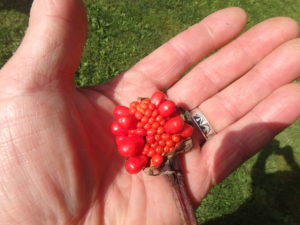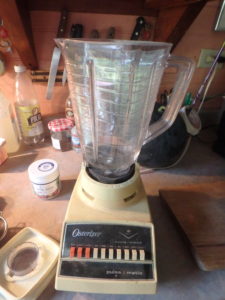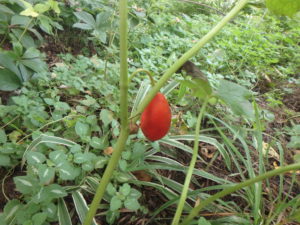Fall Is a Good Time to Plant (Some) Seeds
Most of us think about planting seeds in the spring, but there are lots of plants that can be planted by seed now, especially wildflowers.
One of my favorite wildflowers is Jack-in-the Pulpit (Arisaema triphyllum). In the spring it produces a single well-hidden blossom beneath its large leaves. The plants are either male or female, and it is only the females that produce seeds. Right now in my woods and shade gardens the bright red seeds are visible in nice clumps and are ready to harvest and plant.
The seeds of Jack-in-the Pulpit contain calcium oxalate that can be an irritant to your skin. So you may want to wear latex gloves to handle the seeds. The easiest way to prepare seeds for planting it to put them in a blender with a cup of water and give them a quick whirl. The red mushy part comes right off, leaving clean white seeds. Once the seeds are clean and dry, they are fine to handle with bare hands. Removing the pulp on seeds removes compounds that inhibit seed germination.
Pat the seeds dry with a paper towel and plant immediately. Don’t let them dry out. I use my CobraHead weeder to loosen the soil, then place the seed on the surface and lightly cover with soil and forest duff. Next spring each seed will produce just a single round leaf, and it will be 3 years before a plant will blossom.
If you like eating ramps or wild leeks (Allium tricoccum), you should start a patch of your own. Go out now to the forest where you have harvested wild ones in the spring to see if you can recognize the plants and harvest seeds.
These tasty onion-family wildflowers show their leaves in early spring, then after the leaves die back they flower with dainty white clusters of blossoms just 5 inches above the ground. When the seeds turn black and the stems start to turn brown, they are ready to harvest in August to September. By now, most of my plants have dropped their seeds, but I found a few still good to pick this week.
I plant them by raking off the leaves of the forest floor, scratching the soil surface, and sprinkling the seeds. I pat the soil, and put leaves over the seeds. That’s roughly what Mother Nature would do (except the part about scratching the soil with a CobraHead weeder).
Blue cohosh (Caulophyllum thalictroides) seeds are ready to harvest and plant now. I have one big clump that I transplanted a decade or more ago, and it has gotten bigger every year, but no new plants have shown up. This year I decided to get proactive. The deep blue seeds are ready to pick.
According to my wildflower bible, Growing and Propagating Wildflowers by William Cullina, what appears to be a berry is actually just a seed with the fruit being the extension of the seed coat. He advises removing that by cleaning in a blender or to ferment the seeds in water for a few days until it falls off. The advantage to the blender is that it will nick or scratch the hard seed coat, making germination easier. Like Jack-in-the-pulpit, blue cohosh will produce just one leaf the first year, as it uses its energy to develop its roots.
Other wildflowers that I am collecting seeds from now include Japanese mayapple (Podophyllum peltatum) and false Solomon’s seal (Smilacina racemosa). I bought my Japanese mayapple from The Fells, a nice non-profit garden and historic estate in Newberry, NH on Lake Sunapee. They offer a good variety of unusual plants each summer.
I particularly like the Japanese mayapple because, unlike our native mayapple, the blossoms appear above the foliage instead of hidden below the large leaves. By collecting and planting seeds I may be able to significantly increase my display with no added expense – so long as I have patience. Most wildflowers take 3 years from germination to flowering.
Wildflowers often require a period of “vernalization”. This means that they need a cold period between the time they are planted and when they germinate. This ensures they don’t start growing now, when winter is just around the corner.
Aside from wildflowers, this is a fine time to plant seeds from annual poppies and foxgloves. Just harvest the seed pods of poppies and check to see if they still have tiny black seeds – just tip a pod upside down and the seeds should fall out into your hand. I sprinkle them now, or in mid-winter, and they always produce some flowers the following summer.
At this time of year I often pick foxglove stems and shake them over bare soil where I would like more plants. Since foxgloves (Digitalis purpurea) are biennials, it’s a two-year process. Next year a few of the hundreds of seeds I disperse will produce rosettes of leaves, and the following year they will flower.
Starting flowers by seed does take patience, and knowledge about how and when to do it. For more on the techniques and requirements of growing wildflowers I highly recommend Bill Cullina’s book, mentioned above. He notes that you should be careful not to harvest too many seeds of rare wildflowers, just gather a few. Good luck!
Henry is the author of 4 gardening books and is a UNH master Gardener. His e-mail is henry.homeyer@comcast.net.





